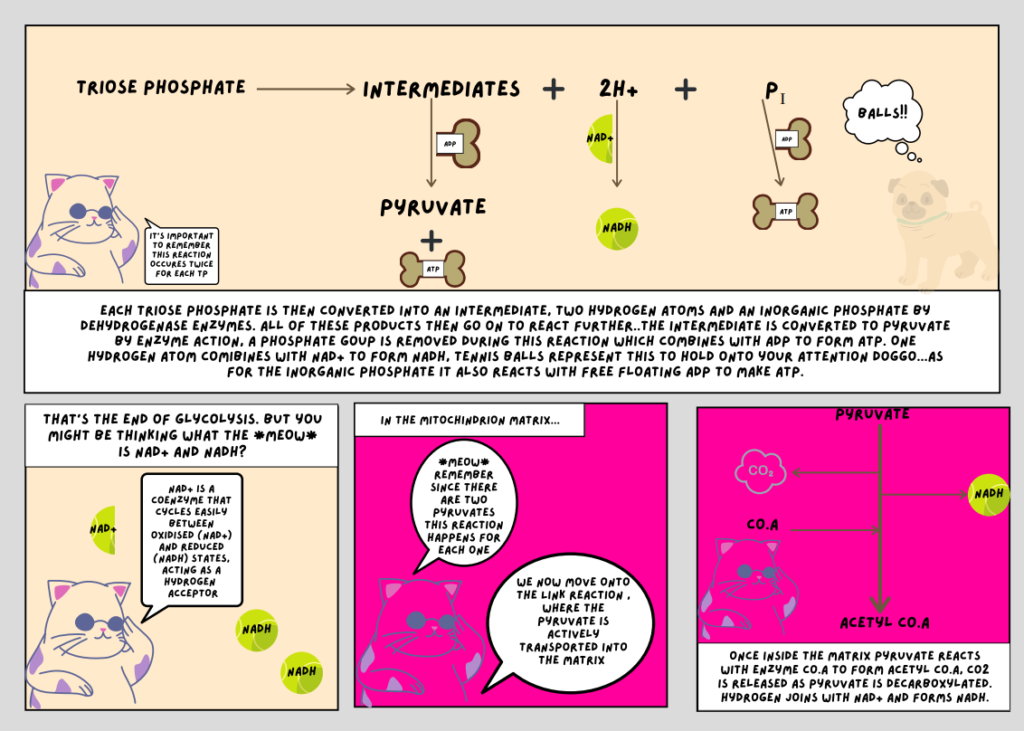Shelini Surendran and Sam Hopkins, Faculty of Health and Medical Sciences
Cellular respiration is a complex topic that students often struggle with, and lecture presentations are usually ineffective in helping students cement the processes. From experience, students have a wide range of misunderstandings and misconceptions about the stages of respiration and a common technique for revising this topic is based on rote learning.
After reflecting on how we could improve our delivery of Cellular respiration, we decided to create an active teaching method. We wanted our students to convey important scientific messages in a more digestible and interesting way. One of the methods that struck us was the use of comic strips. Traditionally, comic strips have been largely ignored in science education and have been seen as a resource primarily aimed at children. It should be noted that comic strips have the power to carry important messages, in a more interesting way compared to a textbook (Koutnikova, 2017). The main purpose of our activity was for students to create a comic strip using online comic strip generators, that would then be marked as a formative assessment.
Our students were first taught about the four stages of cellular respiration in an online lecture on zoom. The week after the lecture students then attended an active learning session over zoom (2 hours), where they were asked to create a comic strip in teams of 4-5. Students were recommended to use comic strip generators such as: ‘Canva’ or ‘Pixton’. Our students were encouraged to use textboxes to describe the comic strip panels and speech bubbles to indicate dialogue between characters. Students were required to embed technical words within their comic strip e.g. ATP, electron transport chain, NAD. Finally our students were asked to write their comic strips in a creative way, for example they could portray the mitochondrion as a ‘electricity cat’ , ‘superhero’ or any other fun character. The role of the teacher was to act as a facilitator and assist students with idea generation for their story line. After the students finished their task, they were then graded on a score out of 50 based on the following criteria: Theme, illustrated scenes, character & dialogue, spelling, grammar & punctuation; and creativity.
Overall, the student response was positive and there was an obvious enhancement of creative thinking, personal expression, and communicative skills. It was interesting to use an alternative formative assessment to check understanding. One of the main advantages of this method was that students had to understand the concepts well enough to create the cartoon but had the support of their teammates for peer learning if anyone who was unsure. Another advantage was students were not required to have any previous artistic skills to use the online comic strip generators and they could learn how to use the comic strip generators quickly as it was self-explanatory. Additionally, classroom management was minimal, and students enjoyed the playful nature of the activity. Some of the feedback from students included:
“Comic strips are so fun and add a twist of humour to the class. It’s always the funniest moments and fun activities in life I remember, as opposed to the dull moments” – Student A
“Assessing us through our comic strip is more interesting, than writing an essay / doing an oral presentation. I think assessment doesn’t have to be boring, and our comic strip task is proof of this” – Student B
“We enjoyed thinking about the process in a more creative way and thought that it was more interactive than a lecture. As we had creative freedom we could have a lot more fun with the concepts involved and found that it made us remember the topic a lot more. We also found that the experience felt a lot more relaxed than the usually assigned university work” – Student C
Although this activity worked well within our classroom, it may depend on the cohort, and may be more practical to conduct the activity in a computer lab with supervision to check student engagement.
An example of a comic strip produced by students Daria Danielewicz and Emil Nikadon is shown in Figure 1.

Figure 1 Excerpt from a comic strip about cellular respiration produced by our Foundation year students Daria Danielewicz and Emil Nikadon
Useful resources for comic strip generation:
https://www.storyboardthat.com/storyboard-creator
Reference:
Koutníková, M., 2017. The application of comics in science education. Acta Educationis Generalis, 7(3), pp.88-98.